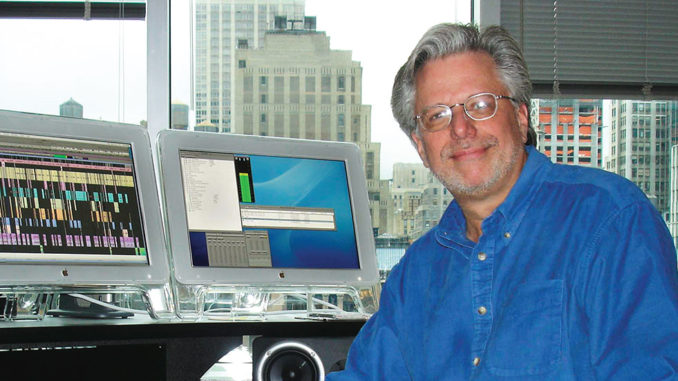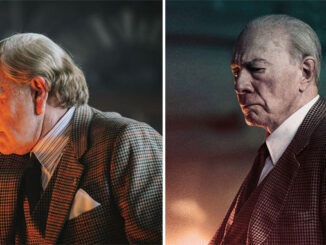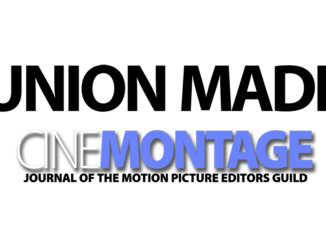
by Megan Cunningham
Geof Bartz, who has worked in the film industry for over 30 years, has received two Academy Awards for his film editing. Before he joined HBO’s staff, Bartz’s documentary editing credits included many of the cult classics-such as Pumping Iron and Stripper-that nontraditional documentary viewers watch repeatedly.
“To me, the whole challenge of editing is to try to get people inside of a story,” Bartz says. “I’m very devoted to storytelling.” Not coincidentally, he started out as a cinephile and an audience member. In college he majored in biology, but joined a film society as an undergraduate. “We’d get together and watch these great, original films that you couldn’t see anywhere else. I saw the rushes of Gunsmoke, and first came across the idea that there is a scene that’s played, and then replayed three different times, cut different ways by different editors. It was like the scales fell off my eyes: It didn’t come out of the camera that way! Somebody made decisions to link those shots that way.” This was a different way of experimenting, and Bartz knew he wanted to become a film editor.
Bartz attended film school at Columbia University with many of the leading producers and editors working in filmmaking today. Later, he taught film editing in the graduate division at Columbia, using the same rushes that originally inspired him. “I give the rushes to my students to cut their own way. I’ve probably seen those scenes cut 300 different ways. And they are all different-it’s different every time. Some of them are really very good! And some of them are pretty bad-but the idea is that there’s this experimentation that’s possible with editing film that is not possible with any other medium. I’m fascinated by that.”
As an educator, Bartz developed a rare talent for communicating what is to many an indecipherable art form: the craft of documentary editing. His own work has been for great producers such as David Grubin (The American Experience: “LBJ”, “FDR”, “TR”, “Truman” and America: “1900”) and Albert Maysles. He describes his editing style as “not fiashy,” but he devotes his attention to meticulous story structure and “good cutting.” His concern, first and foremost, is with entertaining the audience by drawing them into the narrative through character development. To that end, he fights to limit the amount of exposition needed to tell the story, and often advocates for limited narration or title cards-referencing the style of original vérité filmmakers, but with a contemporary flair.
“What you want to try to do is let the story unfold-start with something weird or surprising or wacky or mysterious.” – Geof Bartz
Today, Bartz uses his aptitude for verbalizing cinematic concepts to work with both seasoned and novice filmmakers as supervising editor for HBO, where he has edited or consulted on dozens of award-winning films, often as the unsung hero of the project. As president of HBO Documentary Sheila Nevins relates the story, “I met Geof as an admirer—his credit rolling by on a screen–I didn’t meet him as an employer. I guess I’m still an admirer. Or, I should say, a worshipper. I saw some show about the brain.then I’d also seen Pumping Iron, and I had recognized the same spelling of that name. I thought that both of those were very brilliantly assembled.”
Nevins was buying more documentaries made by independent filmmakers, and she hired Bartz as HBO’s “resident physician.” A staff arrangement as super-vising editor for documentary programming at a network as prolific and prestigious as HBO is a unique position in the documentary editing field, as most long-form projects are cut by freelance editors who are hired by independent producers. Hence, Bartz holds a coveted position among editors. For him, it is an opportunity to work in an uncensored, advertising-free environment, where “you can really show real stuff: violence, sex, everything.” Nevins describes the job as “inseparable from the success of what we do, and the remaking of the either completed or the needing-to-beremedied documentary that we might acquire. The filmmakers tend to love him, and they love their film being repaired and twisted about and thrown up in the air and coming down again with the pieces in a different order. It’s just been a great collaboration and a great gift to HBO to have him here.”
All the editors I’ve spoken with have discussed the difference between cutting a feature film, in which one works with takes and a script, and cutting a documentary, in which editors discover the story in the footage-in some cases arbitrarily, or independent of the director. Many documentary editors liken this process to scriptwriting. Do you?
Absolutely. When I taught film editing at Columbia University, I used to tell my students that the challenge for fiction film editors was making fake people-otherwise known as actors-believable inside of a ready-made story provided by a scriptwriter, while documentary editors had real people but were challenged to find a dramatic story-or at least a compelling structure-somewhere, somehow in the hundreds of hours of footage that is dumped in their laps.
“I always look to the next scene to tell me something new. If it’s information, or an emotion that you’ve already felt, show them something else..” – Geof Bartz
Now it’s true that scriptwriters can go anywhere they want in their heads to solve a story problem while documentary editors are limited to the footage a producer brings to the cutting room. But both must use their imaginations to draw an audience into a story that has a beginning, a middle and an end-or to find a structure that may not be a traditional story but that, nevertheless, builds to a satisfying conclusion.
Tell me about your role as supervising editor at HBO.
One of the goals of HBO is to create something different than what you can get for free on NBC. Sheila Nevins wants to keep people paying their $30 or $40 a month. So what the magazine shows deliver as headlines stated up front, we try to bury in dramatic storytelling. There are three ways in which films come to me at HBO. Sometimes they’re just dailies. Other times there’s a film we’ve acquired, and it’s in progress, in which case I need to work with the director and maybe another editor on making it fit within HBO’s format. And then there’s the third kind: consulting, where I don’t do any of the hands-on editing.
You enjoy the diverse roles you play.
I do. We work with filmmakers who often have very little money, but an enormous amount of passion. It’s important to embrace them, and let them champion their story-because they are often the film’s greatest asset. Exposition and Eliminating Redundancies
Where do you begin, when you work with a filmmaker who is new to HBO and [his] film succeeded on the festival circuit, but HBO feels it needs “medicating?”
Well, entertaining is a dirty word for some people, but to me it’s what you should be focusing on as an editor. Focus on cutting out all the boring stuff, all the information that gets repeated again and again. Sometimes, as a director, you don’t even know that you’re being redundant-but I always look to the next scene to tell me something new. If it’s information, or an emotion that you’ve already felt, show them something else.
“The whole challenge of editing is to try to get people inside of a story.” – Geof Bartz
When you first start working with them, many documentary filmmakers are not concerned with making an entertaining film?
One of the most common mistakes filmmakers make is they get caught up in how you reveal the exposition. People often begin a film with all these facts, all this background on the characters or on the subject-information that you think the audience needs to know. What you want to try to do is let the story unfold-start with something weird or surprising or wacky or mysterious. There are different philosophies on what that first scene should be; some people like to start with a straight-cut interview. I rarely do that-but sometimes it works. If you do start with a talking head, then at least start at a really unusual point in the interview, to arouse the audience’s curiosity.
Documentary filmmakers often feel they need to explain the issue, which gets in the way of cinematic storytelling. But how do you determine what the audience needs to know, and what should be allowed to be discovered through the footage?
Sometimes you do have to start the film with a few facts. Like we just took a film that was edited in Poland, and we cut it slightly here. It was called The Children of Leningradsky, about homeless children who lived in subway stations in Moscow. There were about 30,000 of them. But the film that we got didn’t have any big idea at the head of it. You weren’t sure: Are you just watching the lives of 12 kids who happen to live in subway stations, or is this just a little slice of life? We did put a title card, a fact, at the head of that film: “In the former Soviet Union there are three million homeless children, children without their parents; 30,000 in Moscow, many in the subway stations.” So all of a sudden you give a context to this story and hope that they’ll take it as not just a little slice of life, but a slice of a much larger piece of life.
You’re orienting viewers, setting up the scope of the problem so that when you introduce specific characters that bring the story to life, their stories have more weight.
Yes. Another example is…I worked with a filmmaker [Cynthia Wade] on the initial cut called Shelter Dogs, about dogs in shelters. When I first heard about that film I thought, “It’s a nice little story about a woman who loves dogs.” But it’s a far more complicated, nuanced film. There are millions of dogs who end up in shelters every year. So what do you do? Are they safe enough to put into homes where there are children? Should you destroy some of them, or keep them locked away in cages for their entire lives? There are philosophical and moral problems there that make it a complex story with twists and turns. It’s a story that goes beyond what you expect this film to be about.
“One of the goals of HBO is to create something different than what you can get for free on NBC… So what the magazine shows deliver as headlines stated up front, we try to bury in dramatic storytelling.” – Geof Bartz
Once again, we started with this fact that there are millions of them every year in the shelters of the United States. So there’s a huge problem. And in her first cut she had taken all the information that she had about the main character and pumped it into the first scene. Everything there was to know about this character: her philosophy, where she grew up, why she does this, how the shelter worked, all this stuff. And what happened is that the viewer was inundated with a bunch of information, not pulled into the story. So in the re-cutting of it we decided we would parse out these facts. What’s something you might need to know at the very beginning? The number of dogs that are affected by this problem. Then we had to figure out how long can the story go where you just see her working with the animals, working with people who drop off animals, putting animals in cages, and wondering whether or not they’re going to be adopted. Then, it can come to a piece of information—such as where does she come from and why does she do itfi If you do that, if you pull that off, people are going to listen to the why and the wherefore—but if they haven’t seen her actions, they don’t really care about her. They’re not drawn into a story. To me, the whole challenge of editing is to try to get people inside of a story.
How do you do that—put the viewer inside of a story?
The way I really like to think about it is to get them to step onto a boat that’s going down a river, which just allows them to be carried along the river. But along the river there are going to be some landmarks, and some signs along the way, that are going to tell you a little bit about this river. You’ll be drawn along, you’ll be drawn into the story. I think you need the story. That’s why people go to movies; they want to be drawn inside the stories.
(Editor’s Note: This interview was excerpted from pp 241-248 of The Art of the Documentary: Ten Conversations with Leading Directors, Cinematographers, Editors and Producers by Megan Cunningham. Copyright c2005. Used with the permission of Pearson Education, Inc. and New Riders.)





